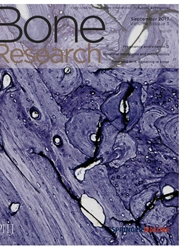

 中文摘要:
中文摘要:
Fibroblast growth factor(FGF)/fibroblast growth factor receptor(FGFR) signaling plays essential roles in bone development and diseases. Missense mutations in FGFs and FGFRs in humans can cause various congenital bone diseases, including chondrodysplasia syndromes, craniosynostosis syndromes and syndromes with dysregulated phosphate metabolism. FGF/FGFR signaling is also an important pathway involved in the maintenance of adult bone homeostasis. Multiple kinds of mouse models, mimicking human skeleton diseases caused by missense mutations in FGFs and FGFRs, have been established by knock-in/out and transgenic technologies. These genetically modified mice provide good models for studying the role of FGF/FGFR signaling in skeleton development and homeostasis. In this review, we summarize the mouse models of FGF signaling-related skeleton diseases and recent progresses regarding the molecular mechanisms, underlying the role of FGFs/FGFRs in the regulation of bone development and homeostasis. This review also provides a perspective view on future works to explore the roles of FGF signaling in skeletal development and homeostasis.
 英文摘要:
英文摘要:
Fibroblast growth factor (FGF)/fibroblast growth factor receptor (FGFR) signaling plays essential roles in bone development and diseases. Missense mutations in FGFs and FGFRs in humans can cause various congenital bone diseases, including chondrodysplasia syndromes, craniosynostosis syndromes and syndromes with dysregulated phosphate metabolism. FGF/FGFR signaling is also an important pathway involved in the maintenance of adult bone homeostasis. Multiple kinds of mouse models, mimicking human skeleton diseases caused by missense mutations in FGFs and FGFRs, have been established by knock-m/out and transgenic technologies. These genetically modified mice provide good models for studying the role of FGF/FGFR signaling in skeleton development and homeostasis. In this review, we summarize the mouse models of FGF signaling-related skeleton diseases and recent progresses regarding the molecular mechanisms, underlying the role of FGFs/FGFRs in the regulation of bone development and homeostasis. This review also provides a perspective view on future works to explore the roles of FGF signaling in skeletal development and homeostasis.
 同期刊论文项目
同期刊论文项目
 同项目期刊论文
同项目期刊论文
 Deletion ofFGFR1 inosteoblasts enhances mobilization of EPC into peripheral blood in a mouseendotoxe
Deletion ofFGFR1 inosteoblasts enhances mobilization of EPC into peripheral blood in a mouseendotoxe Recentresearch on the growth plate: Advances in fibroblast growth factor signaling ingrowth plate de
Recentresearch on the growth plate: Advances in fibroblast growth factor signaling ingrowth plate de Inactivation of Vhl in Osteochondral Progenitor Cells Causes High Bone Mass Phenotype and Protects A
Inactivation of Vhl in Osteochondral Progenitor Cells Causes High Bone Mass Phenotype and Protects A Overexpression of H1 calponin in osteoblast lineage cells leads to a decrease in bone mass by disrup
Overexpression of H1 calponin in osteoblast lineage cells leads to a decrease in bone mass by disrup Serum Bone Alkaline Phosphatase in Assessing Illness Severity of Infected Neonates in the Neonatal I
Serum Bone Alkaline Phosphatase in Assessing Illness Severity of Infected Neonates in the Neonatal I 期刊信息
期刊信息
